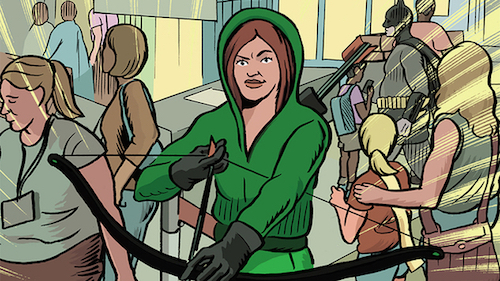Thursday Comics Hangover: Nerd culture stops eating itself

Imagine if cosplay was a thing in the early 1990s. Now imagine that a Fantagraphics cartoonist at the time — Dan Clowes, maybe — made a comic about people who dressed up like superheroes at comics conventions. You could practically imagine the scorn steaming off the page, can’t you? The 1990s alternative comics scene was such a self-consciously self-reflexive organism that it could only refer to comics and nerd culture by mocking it.
Recently, Fantagraphics published a book by Dash Shaw titled Cosplayers. It’s about a pair of nerdy young women — they evoke the leads of Clowes’s Ghost World — who forge a path through nerd culture. And while it would be a gross mischaracterization to call Cosplayers a celebration of nerd life, it’s certainly a far cry from the reflexive hate for all things geeky that you found in the alternative comics scene of the 90s.
The young women in Cosplayers are bored, so they start making films: they record themselves from a great distance, guerilla-style, having interactions with unknowing participants. Then they dub in dialogue over the video. It’s creepy and uncomfortable, but it scores them dozens of views on YouTube, so they keep at it.
Eventually they visit Tezukon, an anime convention in Richmond, Virginia, and a spray of discussions about nerd culture breaks out, like this interaction between a man and a woman at a cosplay contest:
Half of these aren’t from anime.
So?
This isn’t San Diego Comic-Con. It’s an anime con, and Tezuka-specific. I bet these people don’t even know who Tezuka is.
Don’t be an ass.
I’m being a fan!
No you’re not. Real fans love characters. They don’t nitpick about the artists. Chill out.
Another character, once the convention is done, muses, “I feel like the nerdiest thing in the world is to be a jock right now.”
Only one character in Cosplayers — a self-important anime expert — comes across as far too broad. The passages where he pisses in a potted plant or sleeps in a filthy alley are played for laughs, but they feel more like angry mockery than anything else in the book. Perhaps it’s intended to be a commentary on an outmoded style of fannish gatekeeping, but it just comes across as cruelty for its own sake. Every other character has an opportunity to express more than one dimension to their humanity.
The climactic story in Cosplayers works on multiple levels. It’s a critical appreciation of Jack Kirby’s truly bizarre 2001: A Space Odyssey comics adaptation, a story about a bizarre interaction with someone who has taken fannishness to an unhealthy level, and a celebration of collectible comics as semi-holy artifacts. Shaw has added layers of complexity to alternative comics’ relationship to mainstream comics, and in so doing he highlights the strengths and weaknesses of both approaches. It honors what comes before, even as it tears down the past and builds bridges to an uncertain future.